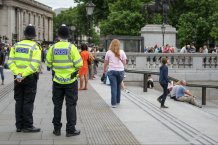
The new national system for reporting use of force, which Dr Abi Dymond from the University of Exeter helped to develop, was introduced for police to submit data in 2017/18, and includes all use of force.
Weapons not used by officers in majority of police incidents involving force, data suggests
Weapons were not used in the majority of police incidents where officers had to use force, the first detailed analysis of statistics from a new national reporting system suggests.
The data analysis, published for the first time, shows handcuffs were used in around three quarters of incidents which involved force. In around a half of such incidents, they were the only force used. Physical action such as restraint was used in a third of cases.
A total of 13 per cent of cases analysed involved the use of one or more types of weapons or equipment, such as baton, irritant spray, dogs, spit guards and limb restraints. A taser was fired in around 1 per cent of incidents reported.
The data analysis also suggests police are more likely to use higher levels of force when dealing with incidents involving people with mental health issues and those perceived to be less than 18 years old, when compared to cases where handcuffs are the only force used. In these situations officers are more likely to draw and physically use equipment or weapons, such as a baton, irritant spray or taser.
When compared to all reported cases involving force where only handcuffs were used, police were more likely to draw, but not to physically use, weapons and equipment, and to use unarmed force, when the person was identified as Black or Black British.
The new national system for reporting use of force, which Dr Abi Dymond from the University of Exeter helped to develop, was introduced for police to submit data in 2017/18, and includes all use of force. Previously data was only collected on the use of firearms, attenuating energy projectiles and tasers.
The first data collected is analysed in a new report, funded by the ESRC and written by Dr Dymond and Dr Katharine Boyd, from the University of Exeter, and experts from the College of Policing. The report analyses data from the 16 police forces in England and Wales who submitted the most data about use of force. Experts analysed 45,661 use-of-force records made during 2017/18 where one officer had used force on a person. The analysis has allowed experts to show the chances of something happening in one set of circumstances compared to another set of circumstances.
Officers reported that they had been assaulted in 5 per cent of all incidents using force – 2,187 cases.
Officers also sustained injuries in around 5 per cent of incidents, though some injuries will have been for reasons other than an assault. Researchers believe the number of assaults and injuries have been underestimated and there are likely to have been differences between officers about what was perceived. The data does not show whether officers were assaulted and/or injured before they used force, while they did so, or afterwards.
Officers were more likely to be assaulted in incidents where they used unarmed force, when they reported using force to protect themselves or others and when officers attended incidents alone compared to cases where they were crewed with another officer who did not use force (single-crewed). Officers were more likely to be injured when the member of the public is reported to have actively or aggressively resisted them, when the officer reported using force to protect themselves or others, and when officers were single crewed (according to the above definition)..
Single crewing was also significantly associated with increased odds of officers drawing and physically using equipment or weapons, going ‘hands-on’, and with Taser being fired.
The statistics show there were 2,522 cases where people were reportedly injured as a result of the force used on them (6 per cent of the total). This includes 290 people who were reported to have been hospitalised because of injuries resulting from police use of force.
Dr Dymond, whose work was funded by the ESRC and is a member of the National Taser Stakeholder Advisory Group, said: “It’s very important for police officers to record what happens when there is use of force, including the use of handcuffs. Building up data can help to support officers to anticipate, prevent and respond as safely as possible to situations.
“I’d like to thank the police forces who provided data for this study and the members of the National Police Chiefs’ Council’s use-of-force recording programme board for supporting the research.
“Of course statistics have limitations, and these are a record of police perception of incidents. But this data offers unique – if tentative – conclusions about public and officer safety, and the police use of force more broadly. They should encourage policymakers, senior police leaders and the frontline to think, reflect and take appropriate action in order tohelp officers manage conflict and improve safety for all.
“By understanding when different types of force are most likely to be used and what the risks are to public and police safety, changes to policy and practice aimed at reducing these risks and improving outcomes can be developed, tested and introduced.”
Date: 2 September 2020
